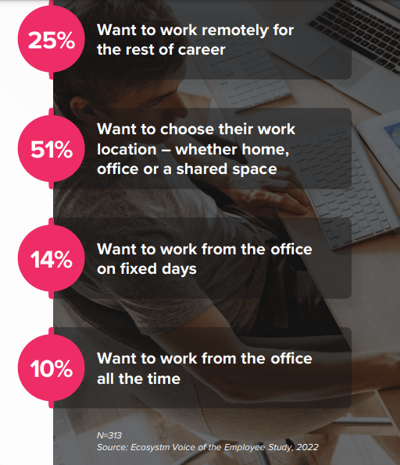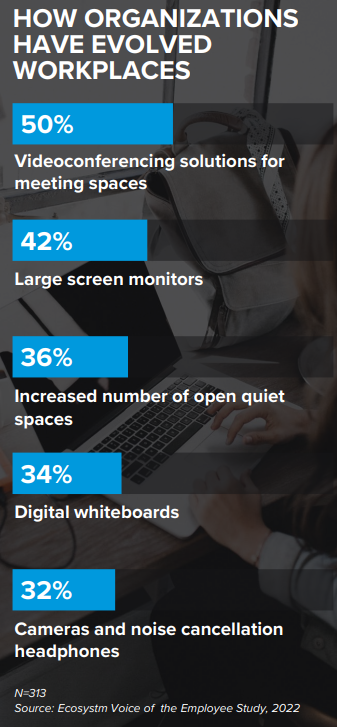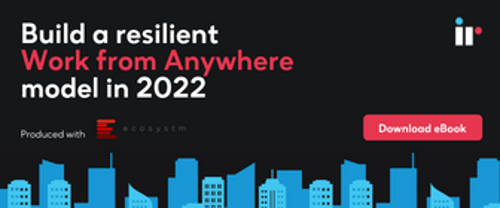In a recent webinar I hosted with our People and Culture Business Partner, Katrina Small, we covered some significant insights and strategies on today’s hybrid workplace experience and what your people expect.
Hybrid working has etched its signature on the global workforce and is fast becoming a precondition for organizations to attract new talent, retain existing talent, and forge a competitive advantage.
But hybrid working also presents challenges to maintaining workplace culture, managing performance and productivity, and ensuring your people feel connected - to one another, your customers, and your company.
The era of 9-5 working hours is quickly dissolving with the emergence of a newer, more flexible, more manageable and satisfying way to get things done.
In this blog I’ll recap some key themes we discussed to help you create great experiences for your people, including:
- Flexibility and fit-for-purpose strategies
- Prioritizing your people
- The role of the physical office
- Rethinking workplace culture
Want to know more? Watch the full webinar.
Flexibility and fit-for-purpose strategies
Flexibility in the workplace was always on the table as ‘nice-to-have’ benefit. It was usually up to employers and management whether they would offer options outside of commuting to the office.
But in today’s working world flexibility is not just a given, it’s an expectation, and it now stands at the centre of an organization’s operations. Not just in terms of working hours, but how and where work is taking place.
A recent joint research project with Ecosystm revealed some interesting findings about what employees want in the workplace.

Alignment between the needs of the organization and the expectations of employees is crucial, and this involves intensive, ongoing communication.
It’s critical to stay in tune with what all parties expect from their working environment and be open to evolving processes and policies as these expectations change.
Key takeaway: Be flexible and adaptable, but be sure to maintain structure.
Prioritizing your people
Employees are an organization’s greatest asset and resource, and also one of the biggest expenditures.
Enterprises are discovering that hybrid hiring is having the beneficial effect of expanding their talent pool. This means they no longer need to restrict their hiring processes to their immediate location.
With geography no longer a barrier, the ability to work remotely increases flexibility for employees and employers, and allows them a competitive edge with access to the best people for the job.
But with this major shift in the way organizations acquire their people, comes the added responsibility of equipping them with the tools they need to work seamlessly, safely, and productively.
Key takeaway: Create a unified experience for all workers, regardless of their role, location, times or where they work.
The role of the physical office
Cloud based technology has allowed freedom, diversity, growth, and the development of a new working culture, and this includes where work actually takes place.
According to Lendlease Property CEO Kylie Rampa, ‘It’s no longer enough to simply provide a desk and chair and call it a workplace’. The days of assigned cubicles where people worked autonomously at a set task every day are disappearing.
While Ecosystm research showed that 75% of employees want to be back in the office at least part time, only about 22% of organizations are reducing commercial office space.
Instead, they are investing in re-designing and redefining what the office looks like, and what the purpose of that space is. Instead of being a destination to perform work, it’s now being used to collaborate and connect, in a world that has been disconnected physically for the duration of a pandemic.

The challenge for organizations is to ensure that the modern office is fit-for-purpose and that there is a seamless interplay between the home and office working dynamic. They need to create collaborative and equitable working spaces. After all, why commute to the office for a virtual meeting or conference, when you can easily do that from home.
Key Takeaway: The office is no longer a place to go to perform tasks; it’s a place to connect and collaborate.
Rethinking workplace culture
Maintaining culture in the same way we thought about it pre-pandemic has been a big challenge for many organizations. Leaders need to create a new narrative of what’s important and valuable to their team.
Within a physical workspace, there is regular interpersonal contact. This human, social interaction is important for psychological and emotional wellbeing. But in a hybrid, digital workplace those interactions don’t happen as naturally.
So, businesses need to rethink what culture looks like figure out what they can do to build and retain a new culture within their hybrid work environment.
For example, it’s important to take time out even when working remotely, to address the social aspect. Re-create the ‘coffee break’ and talk to colleagues online, for the sake of the chat.
Initiate informal catchups. Rediscover and nurture the importance of connecting on a level other than just achieving work outcomes.
It’s important to focus on the mental and emotional side of the new workplace and discover ways to re-invent and replicate ‘water cooler’ moments that help people connect with one another and build the bonds that form great teams.
Employee involvement in creating hybrid strategies can improve the collaborative experience and workplace culture. After all, successful hybrid working can only be possible if all users have a great experience.
Key Takeaway: Rethinking workplace culture means involving everyone on some level, no matter where they’re located.
Make sure the technology works – all the time
Creating a seamless, harmonious, and successful hybrid workplace means that all devices and applications needed to do the job, are performing at optimal level.
Monitoring and performance management is vital if you’re going to future-proof the hybrid workplace. Without the ability to take a precise look at your entire UC and collaboration environment, it’s impossible to see where problems are occurring and fix them.
The collection of data and analytics helps organizations meet the needs and preferences of employees by measuring performance and the experience they’re having, and uncovering innovative new ways to help people connect.
Check out our Ecosystm eBook for more insights on building a resilient 'work from anywhere' model.





